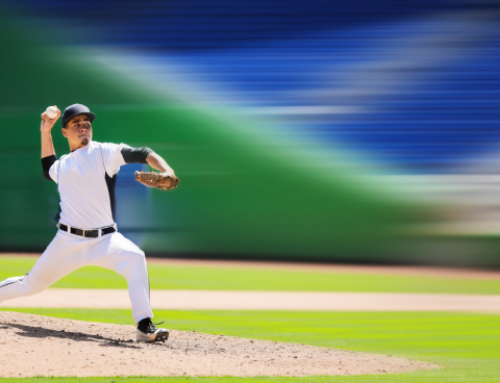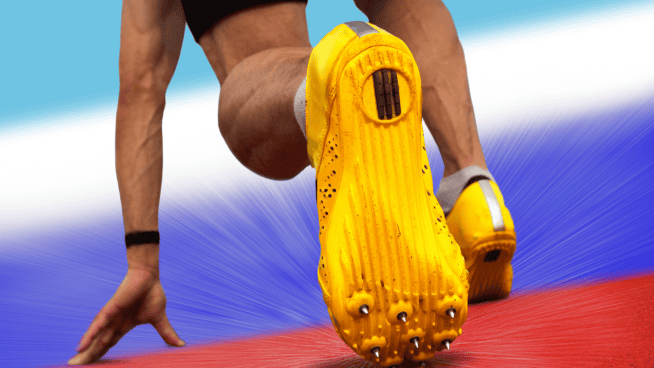CatcherMtrx Training: Proper Throwing Mechanics
As we all know, baseball and softball catchers are judged on their ability to throw out runners. “Pop time” is such a focal point that the concept of good mechanics has almost been forgotten in youth baseball drills. This is a major reason why arm injuries in young catchers are occurring at such an alarming rate. (A Lesson From Joe Mauer: Catchers, Get Your Legs Strong.)
The CatcherMtrx is here to change that. It provides a solution that reinforces mechanics, helps you become more flexible, and makes you an explosive thrower during a game. (See also Tim Collins Half Kneeling Deceleration Catch.)
CatcherMtrx Drill 1: Building Foundation and Timing
Do this drill slowly and in front of a mirror to assure balance, direction and rhythm.
Sets/Reps: 2×12-15
Set-Up
- Set up a line of six to eight balls directly in front of where you will take position.
- These will assure that you don’t drag your right foot during your throw. They will also force you to exaggerate the pick up and put down of your right foot and initial movement.
Drill
- Assume secondary catcher’s position, getting more flexed by raising your butt slightly.
- Keep your back flat and your throwing arm in front of your knee. Have your throwing arm in a relaxed, bent position, ready to frame, block and throw. Stay loose and ready to react.
- Once in position, slowly and precisely bring your right foot over the balls.
- As your right foot strikes the ground, pretend you are about to throw by immediately following with your left foot (i.e., directional foot) placing you in a half squat athletic position.
- At this point, check your form. Make sure your right arm (throwing arm) is in a strong “L” position and your left arm in a strong “J” position. (This position will ensure that energy is not lost, an important part of the release point.)
- The final step is core rotation and extension, crucial to becoming a successful “throwing catcher.”
- As you “release” through the throw, have your right hand in a flat position through the release point (like throwing a pie). This movement will guarantee the correct energy transfer through the ball at the right time.
- Once this takes place, your left arm (a.k.a. your “tuck” arm) takes its final clap destination outside your left pocket or left hip region.
CatcherMtrx Drill 2: Extension and Increasing Distance and Velocity
Set Up
- Follow the structure of the first drill but on a field.
- You will also need a partner and a towel measuring five inches wide by 18inches long.
Set/Reps: 1/10 to each base (1st, 2nd and 3rd)
- Begin in secondary catcher’s stance in front of your partner.
- Have your partner kneel in correlation to the base (1st , 2nd, or 3rd) with his or her catcher’s mitt extended to provide a target.
- Hold the towel in your throwing arm.
- Using footwork like in Drill 1 to each base, propel the towel to strike your partner’s glove/target.
- Add core rotation and torque to aid the movement.
- Start slow in your movements and increase speed as you become more familiar with the drill
- If done correctly, this will teach you to stabilize your head during a throw.
To increase difficulty, add:
- Two Squat Jumps prior to executing your footwork to each base.
- A bungee cord wrapped around your waist to add resistance.
- A hurdle or line of balls like in Drill 1.
- Reps only count when the catcher successfully strikes the mitt of his/her partner.
- Do this drill on a foul line to assure correct balance and direction of your arm.
- Start on a plyo box, jump off into a soft squat while gathering energy and perform the same movement as in Drill 1.
CatcherMtrx Drill 3: Medicine Ball Speed up and Slow Down
Set Up
- You will need a med ball.
- Make sure it is comfortable to control in a throw without losing your balance, direction and energy.
Sets/Reps: 1×10 to each base
- Repeat the same movements as Drill 2, but incorporate the med ball. This will increase resistance while improving balance, energy creation and maintenance.
- Added weight and resistance usually results in a decrease in quality mechanics. Your partner in this drill must critique your performance to assure good quality reps.
- Release the ball outside your left foot. If this is done correctly, the ball will come to an immediate stop and not roll away.
RECOMMENDED FOR YOU
MOST POPULAR
CatcherMtrx Training: Proper Throwing Mechanics
As we all know, baseball and softball catchers are judged on their ability to throw out runners. “Pop time” is such a focal point that the concept of good mechanics has almost been forgotten in youth baseball drills. This is a major reason why arm injuries in young catchers are occurring at such an alarming rate. (A Lesson From Joe Mauer: Catchers, Get Your Legs Strong.)
The CatcherMtrx is here to change that. It provides a solution that reinforces mechanics, helps you become more flexible, and makes you an explosive thrower during a game. (See also Tim Collins Half Kneeling Deceleration Catch.)
CatcherMtrx Drill 1: Building Foundation and Timing
Do this drill slowly and in front of a mirror to assure balance, direction and rhythm.
Sets/Reps: 2×12-15
Set-Up
- Set up a line of six to eight balls directly in front of where you will take position.
- These will assure that you don’t drag your right foot during your throw. They will also force you to exaggerate the pick up and put down of your right foot and initial movement.
Drill
- Assume secondary catcher’s position, getting more flexed by raising your butt slightly.
- Keep your back flat and your throwing arm in front of your knee. Have your throwing arm in a relaxed, bent position, ready to frame, block and throw. Stay loose and ready to react.
- Once in position, slowly and precisely bring your right foot over the balls.
- As your right foot strikes the ground, pretend you are about to throw by immediately following with your left foot (i.e., directional foot) placing you in a half squat athletic position.
- At this point, check your form. Make sure your right arm (throwing arm) is in a strong “L” position and your left arm in a strong “J” position. (This position will ensure that energy is not lost, an important part of the release point.)
- The final step is core rotation and extension, crucial to becoming a successful “throwing catcher.”
- As you “release” through the throw, have your right hand in a flat position through the release point (like throwing a pie). This movement will guarantee the correct energy transfer through the ball at the right time.
- Once this takes place, your left arm (a.k.a. your “tuck” arm) takes its final clap destination outside your left pocket or left hip region.
CatcherMtrx Drill 2: Extension and Increasing Distance and Velocity
Set Up
- Follow the structure of the first drill but on a field.
- You will also need a partner and a towel measuring five inches wide by 18inches long.
Set/Reps: 1/10 to each base (1st, 2nd and 3rd)
- Begin in secondary catcher’s stance in front of your partner.
- Have your partner kneel in correlation to the base (1st , 2nd, or 3rd) with his or her catcher’s mitt extended to provide a target.
- Hold the towel in your throwing arm.
- Using footwork like in Drill 1 to each base, propel the towel to strike your partner’s glove/target.
- Add core rotation and torque to aid the movement.
- Start slow in your movements and increase speed as you become more familiar with the drill
- If done correctly, this will teach you to stabilize your head during a throw.
To increase difficulty, add:
- Two Squat Jumps prior to executing your footwork to each base.
- A bungee cord wrapped around your waist to add resistance.
- A hurdle or line of balls like in Drill 1.
- Reps only count when the catcher successfully strikes the mitt of his/her partner.
- Do this drill on a foul line to assure correct balance and direction of your arm.
- Start on a plyo box, jump off into a soft squat while gathering energy and perform the same movement as in Drill 1.
CatcherMtrx Drill 3: Medicine Ball Speed up and Slow Down
Set Up
- You will need a med ball.
- Make sure it is comfortable to control in a throw without losing your balance, direction and energy.
Sets/Reps: 1×10 to each base
- Repeat the same movements as Drill 2, but incorporate the med ball. This will increase resistance while improving balance, energy creation and maintenance.
- Added weight and resistance usually results in a decrease in quality mechanics. Your partner in this drill must critique your performance to assure good quality reps.
- Release the ball outside your left foot. If this is done correctly, the ball will come to an immediate stop and not roll away.











